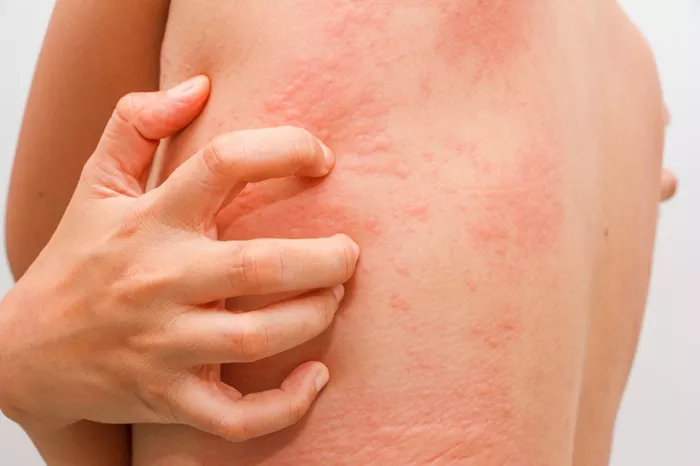Skin allergies affect millions of people worldwide, causing discomfort and impacting daily life. They manifest in various forms, each with unique triggers, symptoms, and treatments. This comprehensive article explores the different types of skin allergies, their causes, and how they can be managed.
1. Contact Dermatitis
Contact dermatitis is one of the most common types of skin allergies, occurring when the skin comes into direct contact with an allergen or irritant. It is further classified into two types: irritant contact dermatitis and allergic contact dermatitis.
Irritant Contact Dermatitis
Irritant contact dermatitis is caused by exposure to substances that physically damage the skin, such as soaps, detergents, and solvents. The symptoms include redness, itching, and dryness, often developing shortly after contact. Unlike allergic contact dermatitis, this type doesn’t involve an immune response but rather a direct toxic effect on the skin.
Allergic Contact Dermatitis
Allergic contact dermatitis results from an immune reaction to a specific substance. Common allergens include nickel, fragrances, preservatives, and certain plants like poison ivy. Symptoms may take hours to days to appear and include redness, swelling, blisters, and intense itching. Patch testing is often used to identify the responsible allergen.
2. Atopic Dermatitis (Eczema)
Atopic dermatitis, commonly known as eczema, is a chronic skin condition characterized by dry, itchy, and inflamed skin. It typically begins in childhood and can persist into adulthood. The exact cause of eczema is unknown, but it is believed to involve a combination of genetic and environmental factors.
Symptoms and Triggers
Eczema symptoms vary from mild to severe and include red to brownish-gray patches, especially on the hands, feet, ankles, wrists, neck, upper chest, eyelids, and inside the bend of the elbows and knees. The skin can become thickened, cracked, and scaly. Common triggers include stress, harsh soaps, detergents, wool, low humidity, and certain foods.
Management
Managing eczema involves moisturizing the skin regularly, using gentle skin-care products, avoiding known triggers, and, in some cases, using prescription medications like topical corticosteroids, calcineurin inhibitors, or biologics.
3. Urticaria (Hives)
Urticaria, or hives, is a skin reaction characterized by itchy welts that can appear anywhere on the body. These welts range in size and can merge to form larger areas of swollen skin. Hives can be acute or chronic, with chronic cases lasting more than six weeks.
Causes and Symptoms
Hives are often triggered by allergic reactions to foods, medications, insect stings, or infections. Other factors include stress, heat, exercise, or exposure to sunlight. Symptoms include raised, red or skin-colored welts that can be very itchy and painful. The welts may vary in size and appear and fade repeatedly as the reaction runs its course.
Treatment
Treatment for hives involves avoiding known triggers, taking antihistamines to reduce itching and swelling, and in severe cases, using corticosteroids or epinephrine. For chronic hives, medications like omalizumab, a monoclonal antibody, may be prescribed.
4. Angioedema
Angioedema is similar to hives but affects deeper layers of the skin, often occurring in soft tissues like the eyelids, lips, throat, and genitals. It can be acute or chronic and is often associated with allergic reactions.
Symptoms and Triggers
Symptoms of angioedema include swelling, redness, and warmth in the affected areas. Severe cases can lead to difficulty breathing if the swelling occurs in the throat. Triggers include certain foods, medications, insect stings, and infections, similar to hives.
Management
Management of angioedema includes avoiding triggers, using antihistamines, and in severe cases, epinephrine or corticosteroids. Chronic cases may require medications that target the immune system, such as omalizumab.
5. Photoallergic and Phototoxic Reactions
These types of skin allergies occur due to the interaction of sunlight with certain substances on the skin, leading to a reaction. They are often categorized as photoallergic or phototoxic reactions.
Photoallergic Reactions
Photoallergic reactions occur when a substance on the skin changes chemically upon exposure to UV light, triggering an allergic response. Common culprits include certain sunscreens, perfumes, and medications. Symptoms include itchy, red, and inflamed skin that resembles eczema.
Phototoxic Reactions
Phototoxic reactions, on the other hand, result from the direct damage to skin cells by UV light in the presence of a photosensitizing agent, such as certain antibiotics and nonsteroidal anti-inflammatory drugs (NSAIDs). This reaction resembles a severe sunburn, with redness, swelling, and blistering.
Prevention and Treatment
Preventing these reactions involves avoiding known photosensitizing substances and using broad-spectrum sunscreens. Treatment includes discontinuing the offending substance and using topical corticosteroids to reduce inflammation.
6. Seborrheic Dermatitis
Seborrheic dermatitis is a chronic form of eczema that primarily affects areas rich in oil glands, such as the scalp, face, and upper chest. It is also known as dandruff when it affects the scalp.
Symptoms and Triggers
Symptoms include red, scaly patches, greasy skin, and stubborn dandruff. The exact cause is unknown, but it is believed to involve a combination of genetic, environmental, and yeast (Malassezia) factors. Stress, cold weather, and hormonal changes can exacerbate the condition.
Management
Managing seborrheic dermatitis involves using antifungal treatments, medicated shampoos, and topical corticosteroids or calcineurin inhibitors to control inflammation. Regular cleansing with gentle, non-irritating products can also help manage symptoms.
7. Dermatitis Herpetiformis
Dermatitis herpetiformis is a chronic, intensely itchy skin condition associated with celiac disease, an autoimmune disorder triggered by gluten.
Symptoms and Triggers
Symptoms include clusters of small blisters and bumps, often on the elbows, knees, buttocks, and back. The exact mechanism involves the immune system reacting to gluten, leading to skin manifestations. The condition is often linked with gastrointestinal symptoms typical of celiac disease.
Management
Management includes adhering to a strict gluten-free diet and using medications like dapsone to relieve itching and blisters. Regular follow-ups with a healthcare provider are essential to manage both skin and intestinal symptoms effectively.
8. Stasis Dermatitis
Stasis dermatitis occurs due to poor blood circulation, typically in the lower legs. It is often associated with chronic venous insufficiency, where the veins have difficulty sending blood back to the heart.
Symptoms and Triggers
Symptoms include swelling, redness, itching, and the development of open sores or ulcers in severe cases. The skin may become thickened and discolored over time. Factors contributing to stasis dermatitis include prolonged standing, obesity, and a history of blood clots or varicose veins.
Management
Management involves improving blood circulation through lifestyle changes such as regular exercise, elevating the legs, and wearing compression stockings. Topical corticosteroids can help reduce inflammation, while treating any underlying venous insufficiency is crucial for long-term management.
Conclusion
Skin allergies encompass a wide range of conditions, each with distinct triggers and symptoms. Understanding these different types is crucial for effective diagnosis and management. Preventative measures, lifestyle changes, and appropriate medical treatments can significantly improve the quality of life for those affected by skin allergies. If you suspect you have a skin allergy, consulting a healthcare professional is essential to develop a tailored management plan.
[inline_related_posts title=”You Might Be Interested In” title_align=”left” style=”list” number=”6″ align=”none” ids=”9151,9148,9145″ by=”categories” orderby=”rand” order=”DESC” hide_thumb=”no” thumb_right=”no” views=”no” date=”yes” grid_columns=”2″ post_type=”” tax=””]































